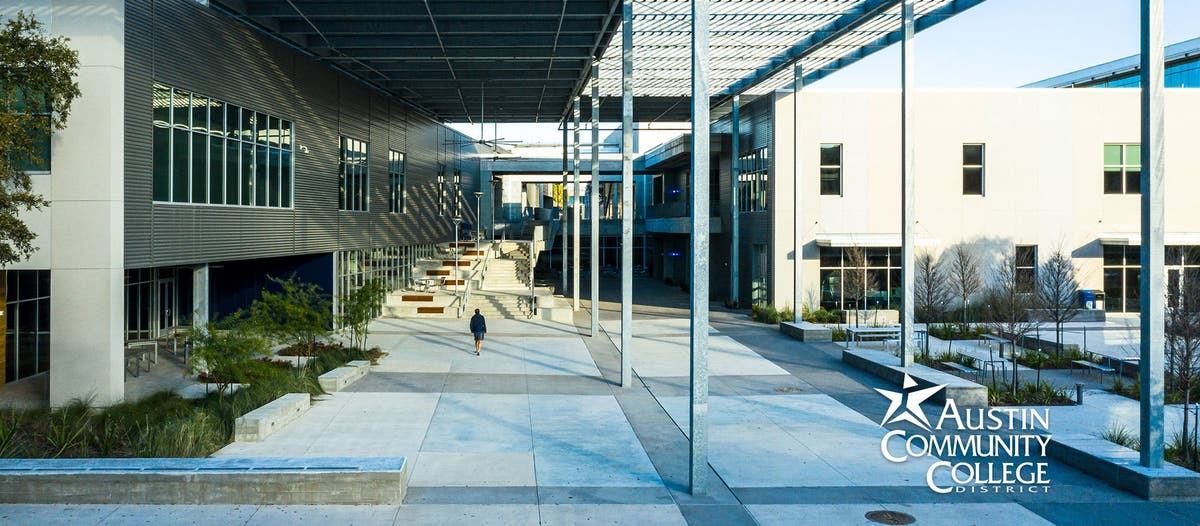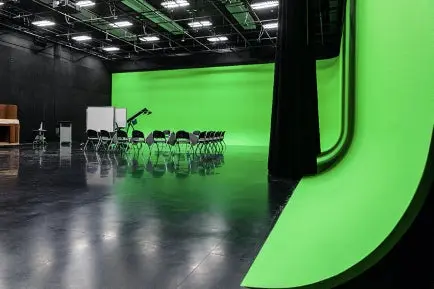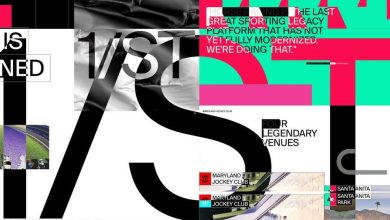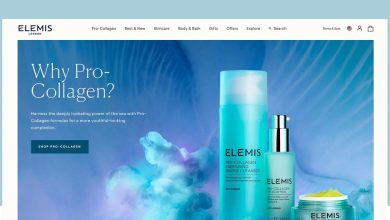Austin Community College prepares students for success in a digital future

Adobe Creative Campus, Austin Community College, is dedicated to preparing students for success in a digital world.
The Paseo at ACC Highland Campus, Building 2000 — January, Friday 22, 2021.
With 11 campuses and more than 70,000 students annually, Austin Community College District (ACC) is one of the largest community college systems in the nation. It’s also the top school in Texas for transferring into public universities, providing an affordable start for students pursuing a four-year degree. As part of the dynamic ecosystem of technology and art that thrives in the Austin area, the institution is dedicated to preparing students for success in a digital world. And, ACC is an Adobe Creative Campus — the country’s first community college to have that distinction.
“Many companies look for digitally fluent employees well-versed in Adobe Creative Cloud,” says Thomas Nevill, Dean of Arts and Digital Media at Austin Community College. “As an Adobe Creative Campus, ACC gives students an advantage and helps them build digital portfolios in an increasingly online world.”
Digital fluency is an important part of ACC’s 2025 Academic Master Plan, with Adobe Creative Cloud at the center of its Digital Literacy Equity and Inclusion for All (DLEI) initiative. As co-chair of the planning process, Nevill recognizes the need to integrate digital skills into every discipline — not only Arts and Digital Media but in Health Sciences, Education, Liberal Arts, and beyond. Today, Adobe Creative Cloud is available at no cost to employees and at a deep discount to students, and his goal is to make Adobe Creative Cloud free for both students and employees in the future. With Adobe Creative Cloud tools such as Adobe XD, ACC is bringing digital fluency to the community college curriculum, exposing people to digital skills who might not otherwise develop them. He wants people to explore the possibilities, and he’s not afraid to lead by example.
“To create the final proposals for the Academic Master Plan, I decided to try something new and taught myself how to use Adobe Premiere Rush, complete with still shots, video, and voice-over,” Nevill says. “It was important for me to take that step and show people that if I can do it, anyone can.”
Indeed, Adobe Creative Cloud tools such as Adobe XD and Adobe Spark are catching on across departments, from User Experience Design to Speech Communication, and ACC makes sure students and faculty have the training they need.
Contents
How ACC is planting the seeds of digital fluency
As Associate Vice President of Academic Programs at ACC, Dr. Gaye Lynn Scott is eager to drive adoption of Adobe Creative Cloud. She oversees programs that reach up to 75 percent of students, including transfer programs in liberal arts, science, engineering, and math — and for her, digital fluency is critical across the board.
“Students should all have the same opportunities to learn and succeed,” says Dr. Scott. “Becoming an Adobe Creative Campus exposes students to digital tools that will serve them in the world after graduation.”
Dr. Scott is a firm believer in the power of “informal but intentional efforts” to drive adoption. That includes recruiting early adopters and seeding cross-talk among faculty, as well as practicing what she preaches. “I intend to be vocal whenever I can, encouraging faculty to replace their slide decks with Adobe Spark,” she says. “Spark is easy yet sophisticated, and it can be a great way to engage students.”
Meanwhile, ACC invests in formal training to support both faculty and students. They rely heavily on Adobe tutorials and LinkedIn Learning tutorials, but the community college is finding creative ways to establish resident experts and get ideas flowing.
“We’re developing a one-year faculty fellowship program around Adobe Creative Cloud, where fellows receive advanced training and get a stipend to redesign a course,” says Matthew Evins, Director of Academic Technology in the Teaching and Learning Excellence Division. “It’s a way to support faculty members who are serious about integrating digital tools into their courses — and a great way to show what’s possible.”
Evins and his team not only train faculty to use technology in the classroom, they also set up audio/visual equipment and support websites. They even produce videos to supplement course materials, using Adobe Premiere Pro and Adobe After Effects to create polished, professional work. During the pandemic, the video production team was busy producing dozens of videos as faculty members looked for ways to replace in-person, hands-on instruction. And the team is increasingly focused on students — providing support for Adobe tools as well as wi-fi, laptops, tablets, and software to make sure students can succeed in their online courses.
The larger of the two multicam Radio, Television & Film studios at ACC Highland Campus, Building 2000 — Wednesday, November 11, 2020.
Students bring designs to life with Adobe XD
It’s no surprise that the User Experience (UX) Design program at ACC is already immersed in digital tools and technologies. “Many of our students are professional designers looking to transition into a UX career, so they already have extensive experience with Adobe Creative Cloud,” says Molly McClurg, Associate Professor of User Experience Design at ACC. “Instead of spending time on learning new tools, students get to focus on creativity and putting new ideas into the world.”
Most of McClurg’s students are well-versed in Adobe Photoshop, Adobe Illustrator, and Adobe InDesign. But she has recently introduced a new tool into the mix — Adobe XD. It’s a fun, refreshing way to engage students in her Survey of User Experience Design course, where she teaches them how to research, ideate, prototype, and test solutions. Near the end of the semester, students conduct the entire design process, working in small teams to create a prototype they can show off.
“Many students decided to address the affordable housing challenge in Austin,” says McClurg. “Because they’re just starting to explore UX design, we don’t put any constraints on them — so they really go big and experiment with fun ideas.”
One of those ideas came from student Carson Stanch, who explored the idea of creating a tiny home for people with chronic medical conditions or mobility limitations, along with a smart home interface for easier control of door locks, lights, heaters, and appliances. Her team used Adobe XD to design wireframes and a working prototype.
Another student, Amy Frazier, decided to tackle the need for safe restaurant takeout orders during the pandemic. Noticing that many local businesses lacked an online ordering process, she used Adobe XD to mockup wireframes that would make it easy for restaurants to take orders on mobile and desktop.
Seeing their ideas solidified in wireframes and prototypes helps McClurg provide useful feedback. “Using Adobe XD, I can assess the details of the individual screens as well as the vision of how everything will work together,” she says. “Plus, students see their ideas come to life, and their faces light up. It’s exciting to see them discover that UX design could be their future.”
Ready for the job market with communication and digital skills
Digital fluency has also become essential in the liberal arts department, thanks to the dedication of faculty members like Theresa Glenn, Chair of Communication Studies. Glenn is on a mission to equip students with strong digital skills, an online portfolio, and a modern, tech-savvy resume as they enter the workforce.
Glenn has found that Adobe Spark is an easy entry point to digital literacy. In her Introduction to Human Communication course, students have been using Adobe Spark to demonstrate their mastery of concepts they learn in her class. That includes conflict management skills such as active listening, perception checking, and assertive messaging — and students do a great job of modeling those techniques on camera.
At the end of the semester, students pull everything together into an Adobe Spark website that serves two purposes, as Glenn points out. “Not only does this project serve as a final exam, students can link to it on their resumes to show employers their competencies in both communication and digital literacy,” she says.
Students have taken the assignments and run with them, producing webpages that would impress potential employers. Check out a Spark page created by student Amurri Davis and another from fellow student Tyler Langlais.
The college experience goes paperless
ACC takes its commitment to digital literacy seriously, and that means using new tools and technologies beyond the classroom. A few years ago, the community college adopted Adobe Sign and Adobe Acrobat DC to go paperless and use e-signatures to make administrative processes more efficient. Today, ACC processes a few thousand electronic documents every month through Adobe Sign — and that number only continues to grow.
“Our primary value as a community college is providing a good education for students, not processing documents — so the more streamlined we can get, the better,” says John Wilsonmay, Product Owner at ACC. “By increasing efficiency, Adobe Sign helps us keep tuition affordable while making the college experience easier and more enjoyable for students.”
The community college uses Adobe Sign for many processes, including faculty onboarding forms, faculty performance evaluations, study abroad applications, and articulation agreements with other universities, which define transfer policies. During the pandemic, faculty members started using Adobe Sign to have students review and sign class rules agreements and syllabi.
By moving to digital workflows and e-signatures, Wilsonmay estimates that ACC has reduced document processing time by as much as two weeks. With Adobe Acrobat DC, administrators create clearer, more effective forms — for example, using required fields to avoid missing information and pop-up boxes to minimize confusion. Instead of mailing or walking paper documents across campus, people rely on automated approval routing and an audit trail of signatures in Adobe Sign to keep things moving no matter how many people have to sign a document.
ACC uses Box as its document storage solution, and integration with Adobe Sign makes it easy to send documents for signature while keeping them in a central repository, with the ability to set deadlines and track workflows. That’s good for everyone in the ACC community, who can focus on what really matters — student success.
Students at ACC are diverse and non-traditional — they might be finishing their high school diploma, earning a degree in nursing or computer science, or simply enriching their lives with a ceramics class. But they all have one thing in common: they are forging their own paths to success. With its commitment to digital fluency as an Adobe Creative Campus, ACC is ready to help them on their journeys.
“No matter where students come from, we meet them where they are,” says Nevill. “That’s one of the most rewarding aspects of working at Austin Community College. We have so many unique and exciting ways to help them reach their goals.”
Source : Adobe









